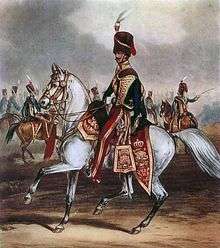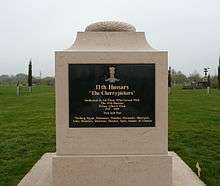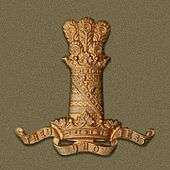11th Hussars
| 11th Hussars (Prince Albert's Own) | |
|---|---|
|
Badge of the 11th Hussars | |
| Active | 1715−1969 |
| Country |
|
| Branch |
|
| Type | Cavalry |
| Role | Line cavalry |
| Size | Regiment |
| Nickname(s) | The Cherry Pickers, The Cherrybums, from which the more genteel Cherubims |
| Motto | Treu und Fest (Loyal and Sure) |
| Anniversaries | El Alamein (23 October) |
| Commanders | |
| Notable commanders | James Brudenell, 7th Earl of Cardigan |
The 11th Hussars (Prince Albert's Own) was a cavalry regiment of the British Army established in 1715 as a regiment of dragoons, serving in Scotland (Culloden); Seven Years' War (Warburg); Napoleonic Wars (Salamanca, Peninsula and Waterloo); Crimea (charged with the Light Brigade at Balaclava); World War I; Arab revolt in the British Mandate of Palestine); WWII (Italian invasion of Egypt; Normandy); BAOR (British Army of the Rhine); and Malaya (Malayan Emergency). In 1969 they were amalgamated with the 10th Royal Hussars (Prince of Wales' Own) to form the Royal Hussars in 1969, which later became part of the King's Royal Hussars.
History
The regiment was founded in 1715 as Colonel Philip Honeywood's Regiment of Dragoons and was known by the name of its Colonel until 1751 when it became the 11th Regiment of Dragoons. A further name change, to the 11th Regiment of Light Dragoons, occurred in 1783.
The regiment's career during the 18th century included fighting in Scotland at the Battle of Culloden as well as service in the Seven Years' War when it took part in the charge at Warburg.[1]



19th and 20th centuries
During the Napoleonic Wars battle honours were received for Salamanca, Peninsular and Waterloo. The regiment's nickname, the Cherry Pickers, came from an incident during the Peninsular War, in which the 11th Light Dragoons (as the regiment was then named) were attacked while raiding an orchard at San Martin de Trebejo in Spain.
In 1840, the regiment was named after Prince Albert, Queen Victoria's consort, who later became the regiment's Colonel. When the regiment became the 11th (Prince Albert's Own) Hussars in 1840, its new uniform by coincidence included "cherry" (i.e. crimson) coloured trousers, unique among British regiments and worn since in most orders of uniform except battledress and fatigues. This was not in memory of the orchard incident but reflected the crimson livery of Prince Albert's house, Saxe-Coburg and Gotha.[2]
The 11th Hussars charged with the Light Brigade (25 October 1854), which was commanded by their former Colonel, Lord Cardigan, at Balaklava during the Crimean War. During the Charge, Lieutenant Alexander Robert Dunn, saved the life of two fellow soldiers from the 11th Hussars, Sergeant Major Robert Bentley and Private Harvey Levett, for which Dunn was awarded the Victoria Cross.[3] Dunn was the first Canadian-born recipient of the Victoria Cross.[4]
Edward Richard Woodham of the 11th Hussars became Chairman of the organising committee for the 21st Anniversary dinner held at Alexandra Palace on 25 October 1875 by the survivors of the Charge. This was fully reported in the Illustrated London News of 30 October 1875 [5] and included some of the recollections of the survivors including those of Woodham.
In the years before World War I, a post card, with a photograph of the 11th Hussars forming an escort through a town, was sent from Sergeant John Kelly, with an extract from the reverse reading "this is the Crown Prince of Germany your honourary Colonel he is in the uniform of the 11th Hussars you will see his ......Guard I further ..... I formed his escort marked 2 man...."

The First World War
Part of the British Expeditionary Force (BEF) under Field Marshal Sir John French, the cavalry were commanded by Major-General Allenby, the 11th, as part of the 1st Cavalry Division first saw action in France at Mons.
When the right flank of the British army was exposed by the French reversal the retreat from Mons led to units being cut off and the fighting confused. The 1st, which included Royal Horse Artillery, reached Nery, 50 miles north east of Paris where a gap had formed.
A large force of German cavalry (numbering thousands) approached Nery heavily outnumbering British cavalry but tired after the long night march. Spotting a column of Ulans 150 yards away. One man fired on them, unaware of the much larger main body of German cavalry. Despite the disparity of forces in the following engagement the Germans withdrew but the fighting exposed British positions which came under heavy bombardment and machine-gun fire, stampeding horses and wiping out the RHA battery with the exception of two sergeants working the one surviving gun (for which both were later awarded the VC).
Encountering a large force of German cavalry the two machine guns of the 11th held off the German advance together with the Bays' Maxims. Their sustained fire, plus the positioning of a ravine, caused a German retreat. In the following pursuit a cavalry charge (complete with drawn sabres) led to the capture of 8 guns, 2 machine-guns and many prisoners. In this action the 11th lost only 2 men wounded and 2 horses (in no small part due through intelligent use of stout farm walls and natural cover rather than the exposure of men and horses to aimed fire in the open).
Messines near Lille and the Belgian border was the site of the regiment's next historic action, part of the BEFs struggle to hold the line at Ypres. After contributing to the general effort to stop the advance of three German cavalry divisions the 11th were ordered to this small Belgian village standing at the southern end of a ridge that provided a vantage point over the surrounding flat countryside, and thus a barrier to the Germans wishing to pass south of Ypres. Fighting dismounted as line infantry the 11th took part in the general action to fight off six fresh German divisions making an all-out assault on the British line.
Heavily outnumbered the British defenders endured a heavy German bombardment of Messines that destroyed 'B' Squadron's trench and that half of them had been buried.
The survivors were rallied and held the line until relieved by the 9th Lancers.
The following morning around dawn a big German attack drove back the 57th Indian Rifles but a counter-attack by the 57th IR, 5th Dragoon Guards and 'C' Squadron of the 11th regained lost ground. During a coordinated infantry and artillery attack one of the 11th's machine-guns engaged the enemy from the top window in one of the buildings (a dangerous place to be as houses all around were being destroyed, evidence by the casualties when the regimental HQ was shelled, most of the senior officers being wounded.
The town was now a place where every man fought with rifle and bayonet, generally behind street barricades and through loopholes hacked out of stout walls. The two day battle resulted in the Germans capturing Messines but at heavy price due to the regiment's level of marksmanship and intelligent use of cover and careful deployment .
During April 1915 the Germans started using poison gas.
In May, the 11th, deployed to the rear of the 2nd Dragoon Guards and 5th Dragoon Guards, reinforcing them with two troops when a severe bombardment destroyed the Guard's trenches. Suffering many casualties who were ordered back to the reserve, 'A' Squadron of the 11th took control of the mixed regimental troops to repair and defend the trench in very difficult circumstances (including a cloud of gas that passed over them in the Hooge-Menin Road area).
Cut off by heavy fighting the 11th fought the Germans crossing the Menin Road. Hooge was held, the 11th fighting beside the Durham Light Infantry and 9th Lancers.
Caulaties for the 11th Hussars in this battle were 3 officers and 24 other ranks dead, 40 officers and men wounded.
The rest of WWI the 11th rotated tasks, absorbing new recruits, training on horses in case the cavalry was needed, and spells in the trenches. (When tanks were introduced the cavalry regiments were not initially involved.) The 200 strong regiment were at Villecholles, east of Vermand, where the order to retire initially caused a panic that was transformed into a more orderly but still desperate retreat.
The 1st Cavalry Division, ordered to hold at all cost the ground between the Somme and the Ancre, saw hard fighting around Sailly Laurette that the 11th were pulled back across the Somme to hold the line at Hamel to block the German advance on Amiens.
Later a bayonet assault of Sailly Laurette with by 120 men took the Germans by surprise and won the village. There were attempts to retake it these were repulsed by the accurate rifle fire that denied them the use of the bridge, this action earning the regiment great praise from all quarters.
The following battle in defence of Hamel included a German bombardment was described by some witnesses are the worst the regiment had felt throughout the whole war.
Hand-to-hand fighting followed, the front was stabilised and Amiens saved but at the cost to the 11th of three officers and 24 other ranks killed and 86 officers and men wounded.
When hostilities ceased at 11:00 on 11 November 1918 the Great War had cost the 11th Hussars 163 killed, 337 wounded and 60 taken prisoner.
The inter-war years
In 1928, the 11th Hussars became the first British cavalry regiment to become mechanized.
In 1936, it became involved in suppressing the Arab revolt in the British Mandate of Palestine.
The Second World War
In 1940, the 11th was located in Egypt when Italy declared war on Britain and France. It was part of the divisional troops of the 7th Armoured Division (known as the Desert Rats). Equipped with obsolete Rolls-Royce and Morris armoured cars, the unit immediately began to conduct various raids against Italian positions during the Western Desert Campaign. The Hussars captured Fort Capuzzo and, in an ambush east of Bardia, captured General Lastucci, the Engineer-in-Chief of the Italian Tenth Army.
The 11th Hussars were part of the British covering force when the Italian invasion of Egypt was launched in September 1940.
The regiment took part in the British counterattack called Operation Compass, launched against Italian forces first in Egypt, then Libya. It was part of an ad hoc combat unit called Combe Force that cut the retreating Tenth Army off near Beda Fomm, fighting under Lieutenant-Colonel John Combe, commander and namesake.
The Italians were unable to break through the defensive positions established by Combe Force and surrendered en-masse as the 6th Australian Division closed in on them from their rear.
Prior to the Normandy campaign, the 11th Hussars were removed from the division and assigned as a corps-level unit in accordance with Field Marshal Bernard Montgomery's view that all armoured car regiments would be assigned to corps, not divisions. Later in the European campaign, the regiment reverted to the 7th Armoured Division.
BAOR and amalgamation
In the 1950s, the regiment served in the British Army of the Rhine close to the border with USSR-occupied Germany, early in the Cold War. The regiment then served in the Malayan Emergency which lasted 12 years.
On 25 October 1969, the regiment was amalgamated with the 10th Royal Hussars (Prince of Wales's Own), to form The Royal Hussars (Prince of Wales's Own). In 1992, the Royal Hussars were amalgamated with the 14th/20th King's Hussars to form the King's Royal Hussars. The 11th Hussars are unofficially perpetuated by 'C' squadron of the King's Royal Hussars.

Notable members
- James Thomas Brudenell, 7th Earl of Cardigan — leader of the Charge of the Light Brigade
- Alexander Roberts Dunn — the first Canadian to win the Victoria Cross
- Tim Forster — Racehorse trainer of 3 Grand National winners
- John Ashley Kilvert — survivor of the Charge of the Light Brigade and later mayor of Wednesbury
- David Margesson, 1st Viscount Margesson — British politician
- Francis Newall, 2nd Baron Newall — British politician
- Nicholas Soames — British politician
- HRH Prince Michael of Kent
- Sir Philip Frankland-Payne-Gallwey, 6th Baronet
- Harry Paget Flashman — fictional anti-hero
- Antony Beevor — writer
- John Frederick Boyce Combe — World War II leader of Combe Force
Battle honours
- Warburg, Beaumont, Willems, Egypt, Salamanca, Peninsula, Waterloo, Bhurtpore, Alma, Balaklava, Inkerman, Sevastopol
- The Great War: Mons, Le Cateau, Retreat from Mons, Marne 1914, Aisne 1914, Messines 1914, Armentières 1914, Ypres 1914 '15, Frezenberg, Bellewaarde, Somme 1916 '18, Flers-Courcelette, Arras 1917, Scarpe 1917, Cambrai 1917 '18, St. Quentin, Rosières, Amiens, Albert 1918, Hindenburg Line, St. Quentin Canal, Beaurevoir, Selle, France and Flanders 1914–18
- The Second World War: Egyptian Frontier 1940, Withdrawal to Matruh, Bir Emba, Sidi Barrani, Buq Buq, Bardia 1941, Capture of Tobruk, Beda Fomm, Halfaya 1941, Sidi Suleiman, Tobruk 1941, Gubi I II, Gabr Saleh, Sidi Rezegh 1941, Taieb el Essem, Relief of Tobruk, Saunnu, Msus, Defence of Alamein Line, Alam el Halfa, El Alamein, Advance on Tripoli, Enfidaville, Tunis, North Africa 1940–43, Capture of Naples, Volturno Crossing, Italy 1943, Villers Bocage, Bourguébus Ridge, Mont Pinçon, Jurques, Dives Crossing, La Vie Crossing, Lisieux, Le Touques Crossing, Risle Crossing, Roer, Rhine, Ibbenburen, Aller, North-West Europe 1944–45
Colonels—with other names for the regiment

The Kerr family provided the colonels for two thirds of the regiment's first century
- 11th Regiment of Dragoons
- 1715 Philip Honywood —Honywood's or Honeywood's Regiment of Dragoons
- 1732 Lord Mark Kerr —Kerr's Regiment of Dragoons
A royal warrant provided that in future regiments would not be known by their colonels' names, but by their "number or rank" on 1 July 1751
- 1752 William, Marquess of Lothian
- 1775 James Johnston
- from 1783 11th Regiment of Light Dragoons
- 1785 Hon. Thomas Gage
- 1787 Joseph, Lord Dover K B
- 1789 Studholme Hodgson
- 1798 William, Marquess of Lothian K T
- 1813 Lord William Bentinck G C B
- from 1840 11th (Prince Albert's Own) Hussars
- from 1969 Royal Hussars (Prince of Wales's Own)
amalgamated with 10th Royal Hussars (Prince of Wales's Own)
- from 1969 Royal Hussars (Prince of Wales's Own)
- from 1992 King's Royal Hussars
amalgamated with 14th/20th King's Hussars
- from 1992 King's Royal Hussars
See also
References
- ↑ Reid, Stuart (1996); 1745, A Military History of the Last Jacobite Rising; Sarpedon 1996: 195–198.
- ↑ "The King's Own Royal Hussars" — Part 9 of the "Regiment" series
- ↑ The Victoria Cross: An Official Chronicle of the Deeds of Personal Valour Achieved in the Presence of the Enemy, O'Byrne Brothers, London, 1865
- ↑ victoriacross.org
- ↑ "Michael Julien's Family History". Archived from the original on 2009-09-24. Retrieved 2009-09-22.
External links
| Wikimedia Commons has media related to 11th Hussars. |
- British Empire Forces; Army Units; British Cavalry; 11th Hussars
- British Army Locations from 1945 British Army Locations from 1945
- Bowling, A. H. (1972). British Hussar Regiments 1805–1914. Almark Publishing, London.
- War diaries of the 11th Hussars
- Illustrated London News of 30 October 1875
